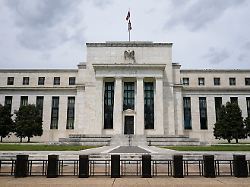“If they require data”
Fed sends signals for interest rate hikes for the first time
April 18, 2024, 6:16 p.m
Listen to article
This audio version was artificially generated. More info | Send feedback
Wall Street has been betting on an imminent turnaround in interest rates for months. But inflation is slow and the US economy is booming. While the date is moving further and further back, the first Fed members are now signaling that an interest rate increase would also be conceivable.
According to monetary authority John Williams, the US Federal Reserve has not decided on a path towards a change in interest rates. If the data situation requires it, increases are also possible, said the head of the New York Fed District at an economic conference in Washington. However, this is not his base scenario. Given the strong economy, the Fed is in no rush to lower key interest rates. However, he expects that it will ultimately decline.
According to US Federal Reserve Director Michelle Bowman, it is unclear whether the level of monetary policy is sufficiently high to combat inflation: “I think time will tell whether it is restrictive enough.” Progress in curbing inflation has slowed, perhaps even stalled, the Fed board member added. The central bank, which will decide on the key interest rate again on May 1st, is currently keeping it in the range of 5.25 percent to 5.50 percent. It wants to sustainably push inflation towards its target value of 2.0 percent.
Markets expect interest rate cut in September
Recently, however, consumer prices rose surprisingly sharply by 3.5 percent compared to the same month last year. In view of the sluggish inflation, the financial markets are now not expecting an interest rate cut until September. Just a few weeks ago there was speculation about June as the likely time for the first reduction. Fed Vice Chairman Philip Jefferson didn’t mention the topic of interest rate cuts in a recent speech. Federal Reserve Chairman Jerome Powell signaled that the tight monetary policy line would have to be maintained for a longer period in order to break the wave of inflation.
Another indicator shows that the US economy is extremely robust: the number of initial applications for unemployment assistance in the US has recently remained constant. Last week, 212,000 citizens applied for government support, according to the US Department of Labor. Experts polled by Reuters had expected 215,000. The four-week average, which did not fluctuate so much, remained at 214,500.
